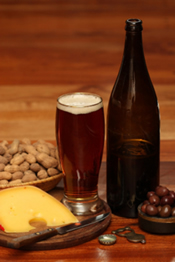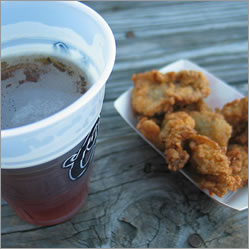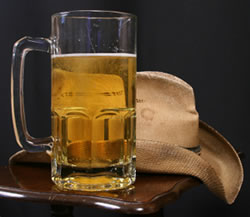One of the greatest benefits of home brewing, and of the golden age of micro brew that we are currently living in, is the ability to create new and unusual brews. The freedom that comes with experimentation in this realm knows no bounds except those of one’s own imagination and ability. With practice and planning, even these limits will increase, as the breadth of knowledge in these fields is naturally increasing. As the golden age of the micro brew expands to even more unique and inventive realms, we are even seeing the list of strange and unique beer that is commercially available expand.
Micro brewers have been experimenting with unique herbal beers well into the origins of beer. Numerous recipes are available for your edification in books such as Sacred and Healing Herbal Beers by Stephen Harrod Buhner, and Wild Fermentation by Sandy Katz. Sacred and Healing Herbal beers is by far the most influential book on brewing that I have had the pleasure to read. My whole career as a hobby home brewer has, in fact, been based on this book, as has that of many home brewers that I know. It is considered in some circles to be the “bible” of strange and unique beer.
To the beer drinkers of the United States, though, even something as simple as a Belgian White Ale is often considered exotic. While the yeasts of such ales certainly lend themselves to distinction, I wouldn’t call them unique beers. To qualify for this category, we must take into consideration the following:
Does the beer have a unique buzz or side effect?
And;
Does the taste of the beer differ due to an admixture?
Yeast has an important effect on the taste of any beer, but this only one aspect of beer production. The quality of the water, the types and mixtures of malts and hops, and especially herbal admixtures affect both of these factors greatly. Inventive processes can also enhance the taste of the beer.
Water is the highest presiding factor over the quality of a beer; it makes up roughly 90% of the beer. I have found that the best beer I have ever been able to brew used as its base pure Alaskan glacier melt water. The list of all-organic ingredients helped, I’m sure, although other organic ales I have drunk have almost lived up to the taste of that ale, most notably the Fishtale Organic Ale. I would call these beers of the highest quality, and the Winter Wolf Stout that I made with the Alaskan Glacier melt water “unique” due to the process of collecting the water.
There is one commercially produced ale that I have discovered to venture into the realm of herbal admixtures, although I am sure more are to come. I am speaking of New Belgium’s Springboard Ale. It is an innocuous sounding name, but this ale is truly a unique herbal concoction brewed up in the guise of a Seasonal beer: a Belgian Ale with the bite of wormwood and the tonic properties of Goji berries.
The Springboard ale boldly forges ahead to reclaim space for herbal beer brewers. Ever since the German beer purity laws, or Reinheitsgebot, adopted in 1516, and even before, the powers-that-be have sought to implement control over what manner of inebriation is allowed to the general public. The only ingredients allowed by law in ale were water, malt, and yeast… hops were added to the list later, by popular demand. The only other brew known to contain an active amount of wormwood ingredient is the infamous Absinthe, outlawed in the U.S. and many other countries, but still sought after and made by high class moonshiners in the United States, and, I am sure, in other countries in which its production has been outlawed.
Before the release of Springboard, the United States saw a proliferation of specialty ales – some of which contained herbs, others of which contained specialty yeasts. A variety of Belgian Ales as well as Fraoch Heather Ale paved the way for the release of New Belgium’s Springboard by exposing the beer fans of the U.S. to more and more strange and unique beers.
In my personal experience, home brewers have been the first to experiment with wild and imaginative combinations in strange and unique beer. I have drunk of the “Orge-Clops-Itar Ale”, containing the herb eyebright, which is regarded as a beneficial tonic for eyesight. The brewer stated to me that the inclusion of eyebright was to help with night vision and goblin sightings. Another unique home brew was the “Skull Crushing Hammer”, a beer made with the herb Yarrow. The herb is said to have immense healing qualities when applied in a salve to open wounds, but when ingested, has inebriatory qualities that enhance the effect of alcohol.
Amongst home brewers is probably the best way to expose one’s self to an amazing variety of strange and unique beers. It may not be the easiest to find home brewers bent on such strange brews, but it will certainly be a rewarding endeavor. It might be worthwhile to enquire at your local home brew supply store about some of the “crazier” brewers that come into the shop.
When home brewing was outlawed with prohibition, it took another 50 years before the state repealed the ban on home brew, and now, finally, craft brewing is overtaking the ground it had lost over 200 years ago. Thanks to the home brew revival, authors like Stephen Harrod Buhner and Sandy Katz, and bold brewers like New Belgium, we are sure to see a revival on the field of strange and unique beers.



 Many kinds of beer work well with oysters. Porter, Stout, IPA. Strong flavors work well to cleanse the palate in between bites so that the fishiness of the oysters is not overwhelming. A good, clean break in between bites is highly desirable. In regions where beer choice is limited, beer is still preferable to non-alcoholic drinks. For raw sea foods, a hard liquor is helpful for keeping any rouge bacteria in check. Tequila and Sake shots especially, although please don’t mix.
Many kinds of beer work well with oysters. Porter, Stout, IPA. Strong flavors work well to cleanse the palate in between bites so that the fishiness of the oysters is not overwhelming. A good, clean break in between bites is highly desirable. In regions where beer choice is limited, beer is still preferable to non-alcoholic drinks. For raw sea foods, a hard liquor is helpful for keeping any rouge bacteria in check. Tequila and Sake shots especially, although please don’t mix.

